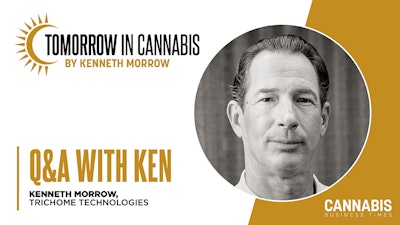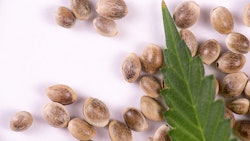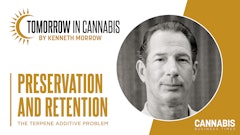
Q. Hi, Ken. I have a much larger harvest pending this season than I have room to dry it. It's primarily destined for extraction. What is the best possible method to preserve the material and its terpene contents until it can be processed and extracted?
A. There are revolutionary technologies being designed and perfected for large-scale cannabis processing that are intended to preserve both the terpenes and the integrity of the product. Below I describe the most advanced method I know of at the moment to perform this function without drying and curing space. It could require purchasing equipment that runs in the tens of thousands of dollars, but the return on investment could be relatively swift with greater yields.
First, harvest all material destined for hand trimming, drying and curing as you traditionally would. The goal for the remainder of the crop destined for extraction is to efficiently remove the resin glands that contain the desired active ingredients while eliminating the undried, unwanted biomass. By following these steps, you can optimize terpene and cannabinoid preservation while saving time by eliminating the need to dry and cure the majority of the material, as well as the equipment and space required. You can also minimize required labor by employing bucking and trimming machines, as described below.
STEPS
1. De-leaf the plant, removing all material that does not have resin glands or trichomes on it.
2. Remove all buds utilizing a bucking machine.
3. Utilize an automated trimming machine to further eliminate any material without trichomes on it.
4. Freeze all buds in a subzero freezer at -20°C in sealed containers to prevent moisture from entering the containers and terpenes from evaporating. Fresh-frozen flower yields the highest terpene percentages.
Once you have fresh-frozen flower, there is an option to process those buds through the preferred form of extraction. The next four steps detail the process to separate only the active ingredients, i.e., resin glands. Extracting pure resin glands rather than whole buds can speed up the extraction process, as whole fresh-frozen buds can take multiple processes to refine. However, as noted earlier, an investment in new equipment is likely required.
5. As needed, remove only the amount of material required using a tumbler or commercial-grade resin separator. All tumbling and sieving also takes place in a subzero environment; -20°C is fine. The best micron dry sift screen size for the initial resin separation is 180 microns. After separation, you will have one grade of resin that still requires further refinement.
6. Freeze dry the bulk resin.
7. Run the freeze-dried resin through a static separator, which further refines the resin by separating the desired resin from any unwanted contaminants such as green particulate matter, plant stigmas or trichome stocks, etc.
8. The trichomes are further refined through a commercial-grade resin separator, with a stack of differing micron screen sizes, at 120-, 90-, 73- and 45-micron dry sift screens. (The larger the number, the larger the screen size.) By utilizing multiple screens of varying sizes, one can target the desired trichome size.
After the final separation, you will inevitably have multiple grades of resin, refined active ingredients that are ready for pressing into rosin or for hydrocarbon, CO2 or ethanol extraction, depending on the grade and preferred extraction process.
Kenneth Morrow is an author, consultant and owner of Trichome Technologies. Facebook: TrichomeTechnologies Instagram: Trichome Technologies Email: [email protected]
About this column: Cannabis industry expert Kenneth Morrow regularly fields questions in response to his “Tomorrow in Cannabis” column in emails and direct messages. Now, Cannabis Business Times is giving people an opportunity to ask questions and get them answered in an open forum. What questions do you have for Ken? Please send all questions to Noelle Skodzinski, [email protected], and your inquiry may be the foundation of the next article.


























